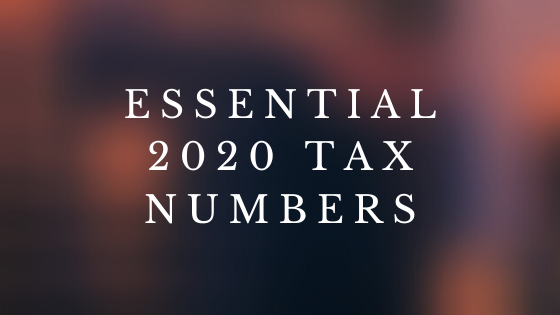
Key Retirement and Tax Numbers for 2020
Every year, the Internal Revenue Service announces cost-of-living adjustments that affect contribution limits for retirement plans and various tax deduction, exclusion, exemption, and threshold amounts. Here are a few of the key adjustments for 2020.
Employer retirement plans
- Employees who participate in 401(k), 403(b), and most 457 plans can defer up to $19,500 in compensation in 2020 (up from $19,000 in 2019); employees age 50 and older can defer up to an additional $6,500 in 2020 (up from $6,000 in 2019).
- Employees participating in a SIMPLE retirement plan can defer up to $13,500 in 2020 (up from $13,000 in 2019), and employees age 50 and older can defer up to an additional $3,000 in 2020 (the same as in 2019).
IRAs
The combined annual limit on contributions to traditional and Roth IRAs is $6,000 in 2020 (the same as in 2019), with individuals age 50 and older able to contribute an additional $1,000. For individuals who are covered by a workplace retirement plan, the deduction for contributions to a traditional IRA phases out for the following modified adjusted gross income (MAGI) ranges:
2019 | 2020 | |
| Single/head of household (HOH) | $64,000 – $74,000 | $65,000 – $75,000 |
| Married filing jointly (MFJ) | $103,000 – $123,000 | $104,000 – $124,000 |
| Married filing separately (MFS) | $0 – $10,000 | $0 – $10,000 |
The 2020 phaseout range is $196,000 – $206,000 (up from $193,000 – $203,000 in 2019) when the individual making the IRA contribution is not covered by a workplace retirement plan but is filing jointly with a spouse who is covered.
The modified adjusted gross income phaseout ranges for individuals to make contributions to a Roth IRA are:
| 2019 | 2020 | |
| Single/HOH | $122,000 – $137,000 | $124,000 – $139,000 |
| MFJ | $193,000 – $203,000 | $196,000 – $206,000 |
| MFS | $0 – $10,000 | $0 – $10,000 |
Estate and gift tax
- The annual gift tax exclusion for 2020 is $15,000, the same as in 2019.
- The gift and estate tax basic exclusion amount for 2020 is $11,580,000, up from $11,400,000 in 2019.
Kiddie tax
Under the kiddie tax rules, unearned income above $2,200 in 2020 (the same as in 2019) is taxed using the trust and estate income tax brackets. The kiddie tax rules apply to: (1) those under age 18, (2) those age 18 whose earned income doesn’t exceed one-half of their support, and (3) those ages 19 to 23 who are full-time students and whose earned income doesn’t exceed one-half of their support.
Standard deduction
| 2019 | 2020 | |
| Single | $12,200 | $12,400 |
| HOH | $18,350 | $18,650 |
| MFJ | $24,400 | $24,800 |
| MFS | $12,200 | $12,400 |
The additional standard deduction amount for the blind or aged (age 65 or older) in 2020 is $1,650 (the same as in 2019) for single/HOH or $1,300 (the same as in 2019) for all other filing statuses. Special rules apply if you can be claimed as a dependent by another taxpayer.
Alternative minimum tax (AMT)
| 2019 | 2020 | |
| Maximum AMT exemption amount | ||
| Single/HOH | $71,700 | $72,900 |
| MFJ | $111,700 | $113,400 |
| MFS | $55,850 | $56,700 |
| Exemption phaseout threshold | ||
| Single/HOH | $510,300 | $518,400 |
| MFJ | $1,020,600 | $1,036,800 |
| MFS | $510,300 | $518,400 |
| 26% rate on AMTI* up to this amount, 28% rate on AMTI above this amount | ||
| MFS | $97,400 | $98,950 |
| All others | $194,800 | $197,900 |
| *Alternative minimum taxable income |
Get the full list of income tax numbers for 2020 here: https://mymoneyguys.com/blog/key-retirement-tax-numbers-2020/
Prepared by Broadridge Investor Communication Solutions, Inc. Copyright 2019 The opinions voiced in this material are for general information only and are not intended to provide specific advice or recommendations for any individual. To determine which investment(s) may be appropriate for you, consult your financial advisor prior to investing. All performance referenced is historical and is no guarantee of future results. All indices are unmanaged and cannot be invested into directly. The tax information provided is not intended to be a substitute for specific individualized tax planning advice. We suggest that you consult with a qualified tax advisor.

